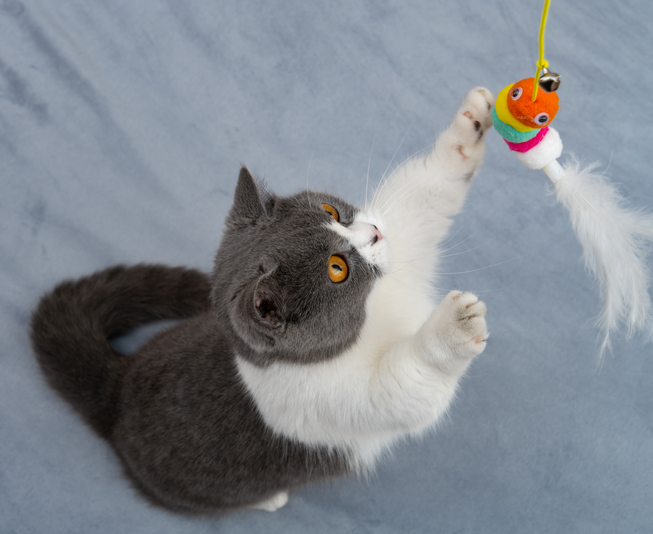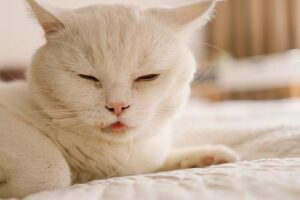While it’s a common misconception that cats sleep all the time, the truth is that they actually need a lot of toys for stimulation and physical activity. Toys also help keep cats entertained, so they don’t look for and find inappropriate things to play with around your house.
Plus, for exclusively indoor cats, toys allow them to act on their natural impulses as predators and “hunt them.” However, each cat tends to prefer some toys over others.
Below, our Broomfield, CO, veterinarians go over the most common types to try if you are just introducing a new cat to your home or have noticed your cat being uninterested in the toys it already has.
Climbing Toys
As born predators, many cats find it entertaining to have “trees,” window hangings, or wall installations that allow them to get up high.
Window hangings and wall installations can be budget-friendly (although, like everything the higher the quality, the higher the price), but the trees—especially the fancier you go, can get kind of expensive. So, make sure you’re taking your cat’s preferences into consideration when you pick the right one. Nobody wants to spend money on something that, well—let’s face it—can sometimes be an eye sore, and that your cats don’t even use. (It’s also recommended to put the tree by a window. This will allow the cat to interact with nature as it plays on the tree, which simulates a feral cat’s experience.)
Hiding Places
For cats who do not like playing up high, sometimes known as “bush dwellers,” toys that provide hiding places, like tunnels, houses, etc., can be great! These kinds of toys provide security for skittish cats and enrichment and exercise for cats with a lot of energy.
If you don’t want to go out and buy a branded cat toy, a cardboard box will likely suffice. Any cat owner, especially after the holiday season, is quick to learn just how much cats love the simplicity of a box (or paper bag)!
Puzzle Toys
Toys that are designed to test your cat’s brain (with a tasty or fun payoff for figuring it out) stimulate your animal’s mind and can be effective in aiding in weight loss.
Toys to Chase
Feather toys, plastic balls with bells inside, and other plushy versions of animals and household items, among many others, can be used for your cat to chase.
Whatever the form, toys that allow your cats to independently play with are essential in letting cats explore their hunting instincts without you needing to be around or at home. If you have particularly active cats, you can try electronic toys.
Wands and Teasers
However, if you do want to be a part of your cat’s playtime, a wand or other type of teaser is a great way for you to do just that! You’ll likely enjoy watching your cat wiggle their butt in excitement and then pounce in the air to catch whatever you’re moving around for them.
These kinds of toys will help you socially bond with your cat, and it will help your cat get some exercise.
Similar to wands and teasers are laser pointers, but they are sort of controversial—as some opine that the unattainable light only frustrates and angers a cat—so, talk to your vet before purchasing that kind of toy.
If you do decide to play with your cat, it’s recommended that you keep in mind how prey reacts in the wildlife. Like with a wand, for instance, you’ll want to do the following:
- Change movements
- Be less obvious
- Use smaller objects
- Never attack your cat
- Let your cat win (i.e., let it catch the toy)
- Understand your cat (like their mobility, age, aggression when playing, etc.)
Catnip Toys
In addition to toys that your cat can chase, such toys filled with catnip encourage some cats to play away.
Catnip, which grows easily and naturally in North America, is ground up plant matter that mimics feline sex hormones. Furthermore, cats have an extra scent organ at the roof of their mouths known as the vomeronasal gland, which serves as a pathway for scents collected in the nose and mouth to be carried to the brain.
Cats who react positively to catnip will demonstrate behaviors consistent with happiness, affection, playfulness, or relaxation. Other cats, however, can become aggressive after coming into contact with it. It’s been said that only 60% of cats actually react to the active components in catnip.
Scratchers
Often scratchers are included on cat trees, but cats (and your furniture) can benefit from having various scratchers throughout your home. Whether they’re hanging from doorknobs or as individual posts, scratchers help your cat let out their instinct to scratch. They can also serve as places to relax or hide.
Maintenance of Cat Toys is Important
With any of the above-mentioned cat toys, keep your eye on them for signs of degradation, and make sure you throw the cat toys away when they start to break. When cat toys start to break, small parts can be a choking hazard, and can get your cat sick.
Ask Our Broomfield, CO, Vets About Cat Toys During Your Cat’s Next Visit
It’s safe to say that toys are necessary for a cat to have a fulfilled life, and fortunately, there’s various types and forms that you can test to find your cat’s absolute favorite!
If you have any questions about what cat toys would be best for your feline, let our Broomfield, CO, veterinarians know during your cat’s next vet visit. To schedule your cat’s appointment, give our animal hospital a call at (303) 469-5363.





